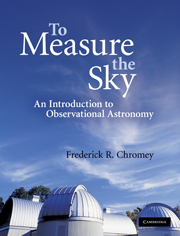9 - Digital images from arrays
Published online by Cambridge University Press: 05 June 2012
Summary
All the pictures which science now draws of nature and which alone seem capable of according with observational fact are mathematical pictures.
– Sir James Jeans, The Mysterious Universe, 1930Astronomers normally present the output of a sensor array in the form of a digital image, a picture, but a mathematical picture. One appealing characteristic of a digital image is that the astronomer can readily subject it to mathematical manipulation, both for purposes of improving the image itself, as well as for purposes of extracting information.
Accordingly, the chapter will proceed by first presenting some general thoughts about array data, and some general algorithms for image manipulation. Because they are so useful in astronomy, we next examine some procedures for removing image flaws introduced by the observing system, as well as some operations that can combine multiple images into a single image. Finally, we look at one important method for extracting information: digital photometry, and derive the CCD equation, an expression that describes the quality you can expect from a digital photometric measurement.
Arrays
Astronomers usually use panoramic detectors to record two-dimensional images and, at optical wavelengths, they most often use a charge-coupled device (CCD). Unlike a photographic plate (until the 1980s, the panoramic detector of choice), a CCD is an array – a grid of spatially discrete but identical light-detecting elements. Although this chapter discusses the CCD specifically, most of its ideas are relevant to images from other kinds of arrays.
- Type
- Chapter
- Information
- To Measure the SkyAn Introduction to Observational Astronomy, pp. 275 - 322Publisher: Cambridge University PressPrint publication year: 2010



